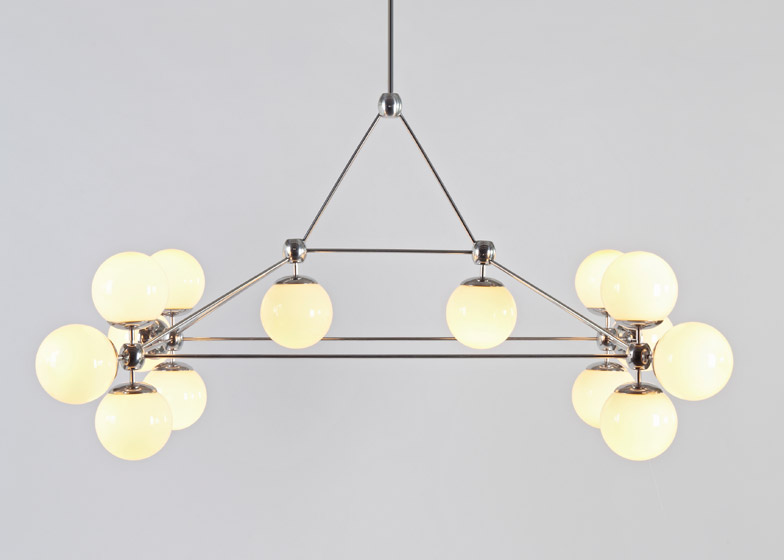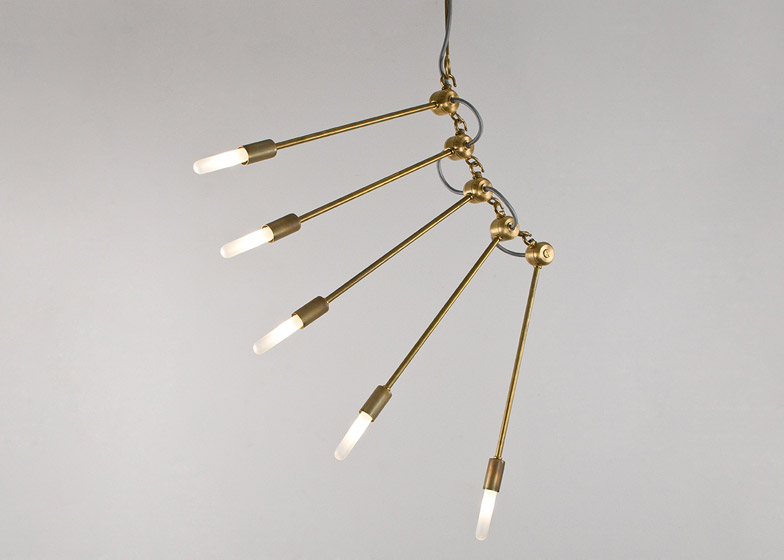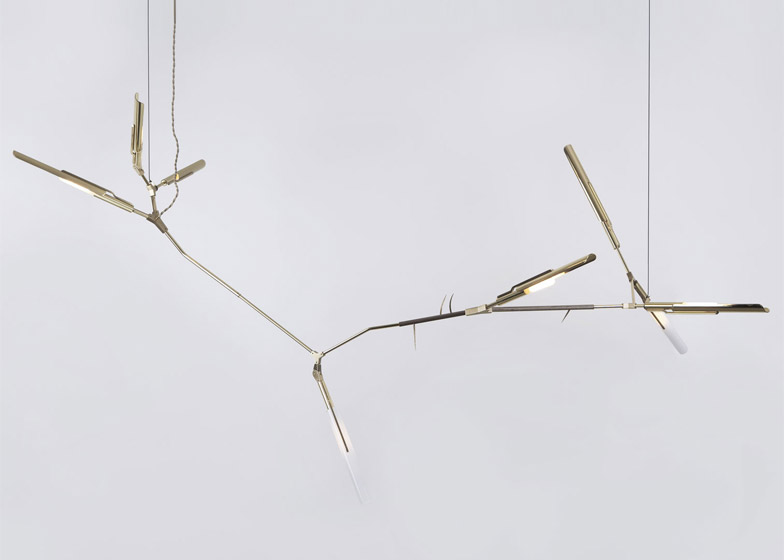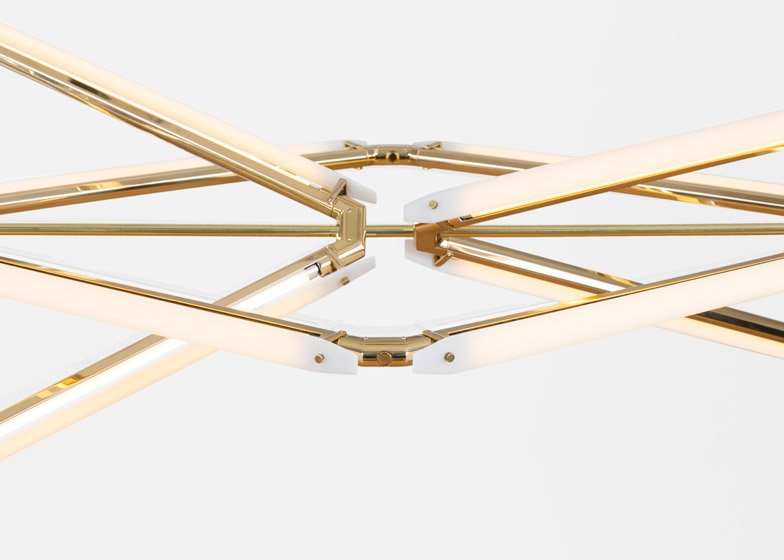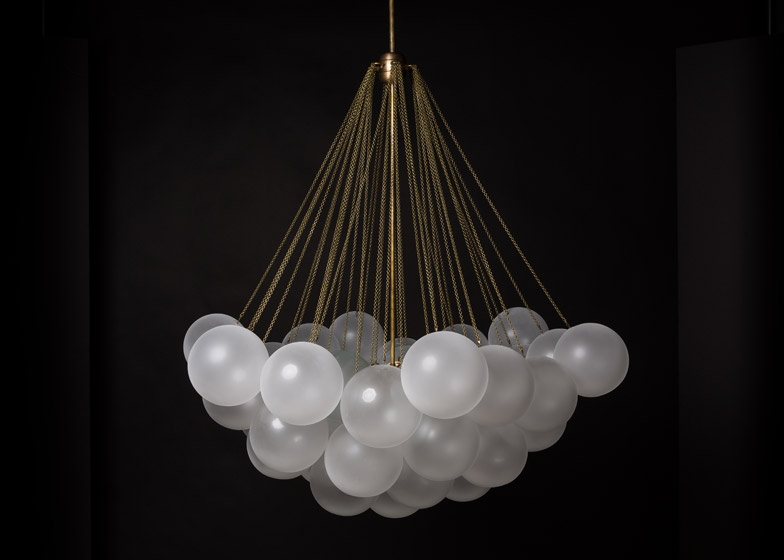New York 2015: the lighting scene in New York is "exploding" according to designers in the city, with young companies joining established names to create a movement with a unique aesthetic (+ slideshow).
A host of new brands have sprung up following the success of pioneers such as Lindsey Adelman, David Weeks and Jason Miller.
"It's just exploding," said Miller, a Brooklyn designer who is founder of luxury lighting brand Roll & Hill. "There's a critical mass of people doing it all at once."
Miller said the energy of the scene is comparable to the great period of Dutch design in the 1990s that saw the emergence of global names including Hella Jongerius, Marcel Wanders and Richard Hutten.
"There was a critical mass of people doing similar interesting work and it just exploded and became an international thing," he said. "And I think there's something like that going on in New York right now in the lighting world."
The new breed of New York lighting designers have a lot in common. They tend to self-produce their products, which are aimed at the luxury market. Their work is large-scale and sculptural but has a slightly retro feel, which responds to the somewhat conservative taste of wealthy New Yorkers. Chandeliers abound.
They favour traditional materials such as brass and opaque glass, and their work often features circular forms and modular connecting elements. And they have often worked under one of the established names before branching out on their own.
"David Weeks was doing lighting first; Lindsey Adelman started working with him and then started [homeware brand] Butter with him before going off on her own," said young designer Bec Brittain, who worked under Adelman for three years before starting her own studio in 2011. "I found Lindsey and was inspired by her and learned under her and moved out on my own."
Brittain, like Adelman, designs lights for Miller's Roll & Hill brand, which also produces pieces by designers including New Yorkers such as Rich Brilliant Willing, Paul Loebach and Rosie Li.
"In some ways it's happening because there's the kind of mentor and mentee relationship and it's expanding from there," said Brittain. "Rosie Li used to work for Jason Miller at Roll & Hill and now she's out on her own doing lighting. So I think it's a kind of generational spread."
The star of the New York lighting scene is Lindsey Adelman, who worked under David Weeks before setting up her own studio in 2006 and has become the major name on the international scene as well as a mentor to local designers. Besides helping Bec Brittain's career, this year she presented products designed by Mary Wallis, a member of her design team, at the International Contemporary Furniture Fair (ICFF) in New York this weekend.
According to Adelman, the financial crash that rocked the city shortly after she established her studio played an important role in the genesis of the lighting scene.
"[The scene took off] just after the crash in 2008-2009," Adelman said. "I think a lot of people wanted to stay as creators and really started looking into options of doing it themselves. Cutting down on overhead, finding other spaces, not taking a salary, setting up a shared workshop, just making it happen rather than relying on other companies, because that wasn't an option. I think for those reasons, there's a huge burst of creativity that came after that time."
Lighting was an obvious choice of product to design, she said, because of its simplicity. She didn't need to rely on big manufacturers and could produce her products herself, or in conjunction with local suppliers.
"I love lighting because it's relatively easy," she said. "It's positive wires and negative wires that get spliced together with a bulb and a socket. A kid could make a light. There's so much freedom in it, it's not like you need a specific type of training. And it's fun, it's spontaneous and there's no right or wrong way to do it."
"Lighting for a number of different reasons really suits the business model of independent designers in a way that a lot of other products don't," agreed Jason Miller. "Being an independent designer is really hard. It's really hard to cobble together a living. And for whatever reason, lighting suits that model well. So there are a lot of designers that are doing it."
The close-knit nature of the New York scene meant that designers often shared suppliers and resources, which in turn has helped forge a coherent aesthetic.
"We all share plating resources, share machining resources," said Bec Brittain. "You ask your friends and your community 'How do I make this?' And you start to see some of the same vendors and the same techniques cropping up. So again it's back to who you learned from and you start to see that persist through different generations."
Many New York lighting designers produce pieces featuring repeated elements, often machined in brass, which is a result of the DIY approach to manufacturing.
"I think a lot of that comes from designers being manufacturers and handling the making themselves," said Russell Greenberg, creative director of Long Island lighting brand Stickbulb. "They need economy of scale so they leverage modular parts multiple times over to make different configurations of lights. It's a more efficient way of having a broader line of products when you're both the designer and the manufacturer. The designer taking control of the manufacturing process has maybe been a factor."
Greenberg said this type of locally designed and manufactured lighting was proving very popular with wealthy New York clients.
"I do think New York as a market is fuelling a demand for luxury, high-end, locally crafted design," he said. "There is a strong consumer base for that. It's a luxury-class purchaser. People are rebelling against the mass-produced overseas product. People really appreciate taking manufacturing back to the US. It's a strong message that's working well for all these companies."
Greenberg agreed that the success of designers such as Miller, Weeks and Adelman helped convince him to set up his own lighting brand.
"It feels good to feel like you're part of something," he said. "Even though we're not in touch with these people and they may not even know who we are, there's a sense of solace in that. There's a level of excitement around being part of that movement."
He added that the scene was attracting attention overseas: "When we were in Milan, the show manager of Rossana Orlandi's showroom said 'Hey, New York is getting interesting from a lighting perspective'."
Another relative newcomer to the scene is Manhattan lighting brand Apparatus, which took a large stand at ICFF this year to present its take on the New York glass-and-brass look. Gabriel Hendifar, the brand's creative director, said his company didn't consciously set out to adopt a similar aesthetic to other designers in the city, saying: "It must be something in the air. We're all drinking the same Kool-Aid."
"There's a scene," added Hendifar. "The door was kicked open by people like Lindsey Adelman and Jason Miller who really defined this high-end market in the US, where clients really invested in the relationship they have with the makers. We've been really fortunate to be working in a time when people understand what it means to make a high-quality item from scratch by people working in New York who are paid fairly and are really invested in using materials that are going to last and things that are crafted in a long-term kind of way."
The scene shows no signs of abating, according to Jason Miller, who said there were plenty of upcoming designers eager to get in on the action.
"I do a lot of crits at universities and half the final projects are lights," he said. "So the ball is really rolling."





